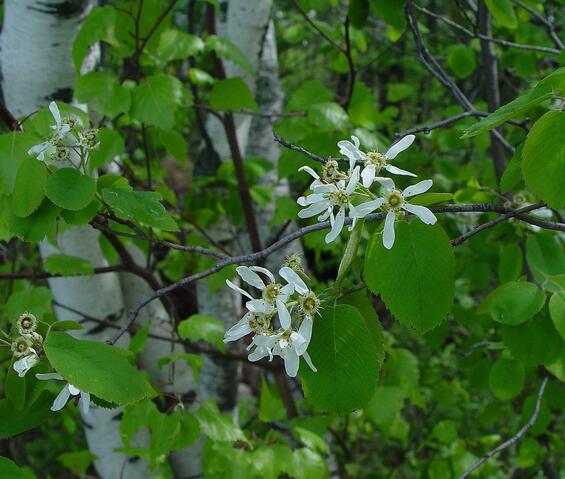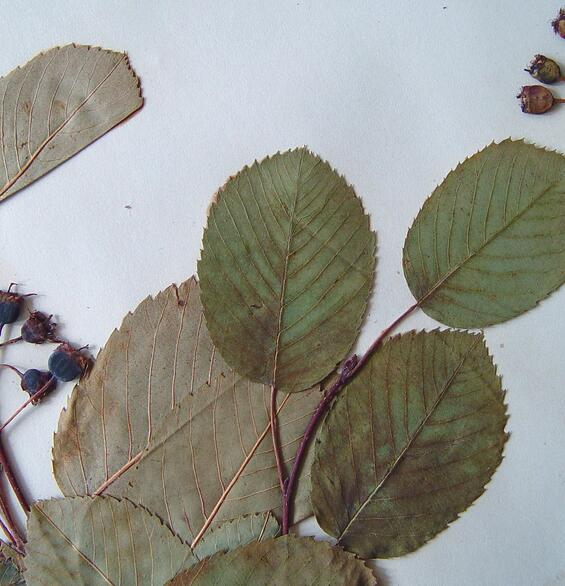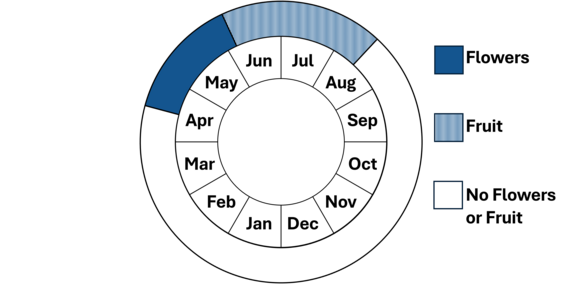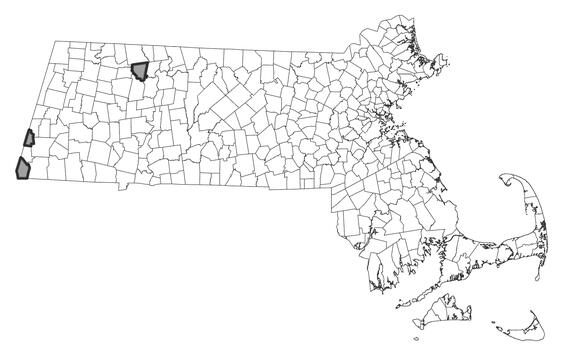- Scientific name: Amelanchier sanguinea (Pursh) DC.
- Species of Greatest Conservation Need (MA State Wildlife Action Plan)
- Special Concern (MA Endangered Species Act)
Description

Round-leaved shadbush flowers. Photo credit: Arthur Haines, Native Plant Trust
Round-leaved shadbush (Amelanchier sanguinea) is a deciduous, straggling shrub which grows singly in a clump on calcareous or sub-acid rocky ledges, outcrops and summits, or rocky outcrops near rivers. It can grow up to 7 m (23 ft) and may form small colonies by spreading rhizomes. A member of the rose family (Rosaceae), it has racemes of white flowers that bloom in late April and early May.
The leaves of round-leaved shadbush are alternate, coarsely toothed with 2-6 teeth per cm (0.4 in) along the edge of the leaf. The leaves have distinct parallel straight mostly unbranching veins that extend into the teeth. The leaves are rounded or slightly cordate at the base 3-7 cm long by 2-5 cm wide (1.2 – 2.75 in by 0.8 – 2 in) with petioles (leaf stems) that are usually 10-18 mm (0.4-0.5 in) long. The hypanthium, or cup-shaped structure below the sepals, is very broad (5 mm diameter [0.2 in]) and more open-saucer shaped compared to other shadbushes. Early in the season, during flowering, the leaves are sparsely to densely pubescence on the upper side and become less so as they mature. The flowers have 5 spathulate shaped petals 11-15 mm long (0.4-0.6 in). The ovary summits of the flowers have dense woolly pubescence. The racemes of 4 to many white flowers are curved or loose-drooping.
Running shadbush (A. spicata, synonymy A. stolonifera) has frequently been confused with the round-leaved shadbush in Massachusetts, leading to reports of more populations than actually occur. Both species have oval to round leaves, that are toothed. Running shadbush may be distinguished from round-leaved shadbush by its colonial growth habit, more finely toothed leaves (4-10 teeth per cm [0.4 in]) with curving, many-branched primary veins, narrower hypanthium (3-4 mm [0.12-0.16 in]), and compact, densely flowered racemes of flowers with shorter obovate petals (6-10 mm [0.2-0.4 in] long), and short lower pedicels (6-18 mm long [0.2-0.7 in]; flowering stalks).The inflorescence of round-leaved shadbush is more open (lowest pedicels are 10-30 mm [0.4-1.2 in]). The underside of the leaves of running shadbush are densely tomentose during flowering.

Round-leaved shadbush leaves. Photo credit: Arthur Haines, Native Plant Trust
Life cycle and behavior

Round-leaved shadbush flowers from mid-April into May (or into early June on the high summits in the Berkshires). The 10 mm (0.5 in) black to dark purple fruits start to ripen in late June and are all fully ripe by August. The fruits fall to the ground after ripening. They are eaten by a variety of birds and mammals.
Population status
Round-leaved shadbush is listed under the Massachusetts Endangered Species Act as Special Concern. All listed species are legally protected from killing, collection, possession, or sale, and from activities that would destroy habitat and thus directly or indirectly cause mortality or disrupt critical behaviors.
Only three small populations of round-leaved shadbush are currently known only from Berkshire and Franklin County since 1999. Historically, seventeen additional populations were found in the state, including in Worcester and Middlesex counties.
Distribution and abundance
The range of round-leaved shadbush extends from New Brunswick west to Saskatchewan, south to the mountains to Georgia. It is considered rare in many states, including as Vulnerable in Iowa, Massachusetts, North Carolina, and Virginia; Imperiled in Pennsylvania and Tennessee; and Critically Imperiled in Illinois, Georgia, Kentucky, Maryland, and New Jersey. In New England, it isn’t known from either Connecticut or Rhode Island, and is considered apparently Secure in Maine, New Hampshire and Vermont.

Distribution in Massachusetts
1999-2024
Based on records in the Natural Heritage Database
Habitat
In MA, round-leaved shadbush prefers exposed riverbeds, riverside ledges, and open to semi-shaded montane ledges and summits. It may be found on gravelly and rocky soil of ridges, slopes and shores; in cracks of open rock faces in cliffs (bordering lakes or ravines); always in part to full sun. The species has been reported to prefer calcareous to circumneutral substrates in other parts of the country, though this is not well-supported in Massachusetts occurrences. Associated species may include a variety of oaks, Danthonia spicata, Deschampsia flexuosa, Gaylussacia baccata, Prunus spp., Solidago spp., Vaccinium angustifolium, V. pallidum and other shadbush species.
Healthy habitats are vital for supporting native wildlife and plants. Explore habitats and learn about conservation and restoration in Massachusetts.
Threats
Threats to round-leaved shadbush include alterations to flood regimes along rivers, which may include changes in the periods of inundation, physical scour and subsequent succession. Competition from non-native species along river shores is also a concern. Trampling and soil compaction by hikers may threaten summit populations. As this is a species of open land, it may be negatively impacted by canopy closure.
Conservation
Survey and monitoring
Round-leaved shadbush is best surveyed when in bloom and may be easily overlooked at other times of the year. It grows in difficult to access locations, such as steep rocky slopes and mountain summits. As the populations in Massachusetts have decreased recently, regular surveys are needed for this species, with assessments of potential negative impacts on the populations so that action may be taken.
Management
As with many rare species, the exact management needs of round-leaved shadbush are not known. Protecting the habitat of this species requires maintaining open or low-density over-story vegetation. At riverside ledges, flooding regimes should be allowed to continue to prevent shoreline succession. Removal of invasive species along river shores may be appropriate if introductions are detected. For summit populations, rerouting trails to avoid direct hiker impacts to round-leaved shadbush may be desirable. To avoid inadvertent harm to rare plants, all active management of rare plant populations (including invasive species removal) should be planned in consultation with the MassWildlife’s Natural Heritage & Endangered Species Program.
Research needs
The exact effect of climate change on round-leaved shadbush is not fully understood. Related species (i.e., Amelanchier canadensis) have been noted to begin blooming and leaf out approximately 10 days earlier in D.C. (Abu-Asab et. al. 2001), and other rose family species that bloom early have been noted to have shifted their flowering time earlier in Massachusetts. Such shifts may disassociate the blooming periods from their pollinators; but there is no information for this species.
More in depth genetic studies of this and related species may also be helpful.
References
Abu-Asab, M. S., P. M. Peterson, S. G. Shetler and S. S. Orli. 2001. Earlier plant flowering in spring as a response to global warming in the Washington, DC, area. Biodiversity and Conservation 10: 597–612.
Campbell, C. S., M. B. Burgess, K. R. Cushman, E. T. Doucette, A. C. Dibble and C. T. Frye. Page updated November 5, 2020. Amelanchier sanguinea (Pursh) de Candolle. In: Flora of North America Editorial Committee, eds. 1993+. Flora of North America North of Mexico [Online]. 22+ vols. New York and Oxford. Accessed April 26, 2023 at http://floranorthamerica.org/Amelanchier_sanguinea
Gleason, Henry A., and Arthur Cronquist. Manual of Vascular Plants of Northeastern United States and Adjacent Canada, Second Edition. Bronx, NY: The New York Botanical Garden, 1991.
Haines, Arthur. Flora Novae Angliae. New England Wild Flower Society, Yale University Press, New Haven, CT. 2011.
Johnson, Elizabeth A. 2023. Amelanchier sanguinea Rare Plant Profile. New Jersey Department of Environmental Protection, State Parks, Forests & Historic Sites, State Forest Fire Service & Forestry, Office of Natural Lands Management, New Jersey Natural Heritage Program, Trenton, NJ. 14 pp.
NatureServe. 2025. NatureServe Network Biodiversity Location Data accessed through NatureServe Explorer [web application]. NatureServe, Arlington, Virginia. Available https://explorer.natureserve.org/. Accessed: 2/10/2025.
POWO (2025). "Plants of the World Online. Facilitated by the Royal Botanic Gardens, Kew. Published on the Internet; https://powo.science.kew.org/ Retrieved 07 February 2025."
Sorrie, B.A. 1987. Notes on the rare flora of Massachusetts. Rhodora 89: 113-196.
Staudinger, M.D., A.V. Karmalkar, K. Terwilliger, K. Burgio, A. Lubeck, H. Higgins, T. Rice, T.L. Morelli, A. D’Amato. A Regional Synthesis of Climate Data to Inform the 2025 State Wildlife Action Plans in the Northeast U.S. U.S. DOI Northeast Climate Adaptation Science Center Cooperator Report. 406 p. https://doi.org/10.21429/t352-9q86 2024
Weakley, A.S. 2020. Flora of the southeastern United States. University of North Carolina Herbarium, North Carolina Botanical Garden
Wiegand, K.M. 1912. The genus Amelanchier of Eastern North America. Rhodora 14: 137-164.
Contact
| Date published: | March 6, 2025 |
|---|